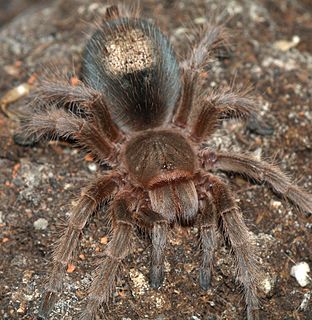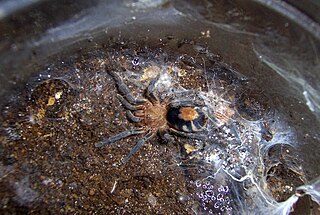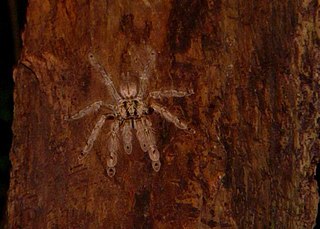
Urticating hairs or urticating bristles are one of the primary defense mechanisms used by numerous plants, almost all New World tarantulas, and various lepidopteran caterpillars. Urtica is Latin for "nettle", and bristles that urticate are characteristic of this type of plant, and many other plants in several families. This term also refers to certain types of barbed bristles that cover the dorsal and posterior surface of a tarantula's or caterpillar's abdomen. Many tarantula species eject bristles from their abdomens, directing them toward potential attackers. These bristles can embed themselves in the other animal's skin or eyes, causing physical irritation, usually to great discomfort. The term urticating hairs is a misnomer, as technically only mammals possess true hairs.

Tarantulas comprise a group of large and often hairy spiders of the family Theraphosidae. Currently, 1,010 species have been identified. The term "tarantula" is usually used to describe members of the family Theraphosidae, although many other members of the same infraorder (Mygalomorphae) are commonly referred to as "tarantulas" or "false tarantulas". Some of the more common species have become popular in the exotic pet trade. Many New World species kept as pets have setae known as urticating hairs that can cause irritation to the skin, and in extreme cases, cause damage to the eyes.

Megaphobema robustum, known as the Colombian giant tarantula or Colombian giant redleg, has a span of 6 to 8 inches, being first described by Anton Ausserer in 1875. Found in the tropical rainforests of Colombia and Brazil near logs, it will eat crickets, other large insects, small lizards and various mice.

Aphonopelma moderatum is a species of spider in the family Theraphosidae, found in United States, in the state of Texas. Commonly called the Rio Grande Gold Tarantula as they are found in the Rio Grande Valley of Texas.
Aphonopelma bicoloratum, is a species of spiders in the family Theraphosidae, found in Mexico. As it common name aptly states it is found in Mexico, and was first described by Ronny Struchen, D. Brändle and Gunter Schmidt in 1996. It is named after the latin word "bicoloratum" meaning bicolored. This tarantula is sometimes kept as pets, and are highly desired as such, though are rarely kept as such do to the price of this spider.
Cardiopelma is a genus of spiders in the family Theraphosidae. It was first described in 1999 by Vol. As of 2017, it contains only one species, Cardiopelma mascatum, known only from Mexico, in the state of Oaxaca.

Phormictopus auratus, commonly known as the Cuban bronze tarantula, is a species of tarantula endemic to Cuba. It is found in the provinces of Camagüey, Las Tunas and Holguín. It was first described by David Ortiz and Rogério Bertani in 2005, and was named after golden hairs found in this species, auratus meaning golden in latin.
Grammostola grossa, the Guarani giant tarantula, is a tarantula that, like all species of the genus Grammostola, is native to South America. It occurs in Brazil, Paraguay, Uruguay and Argentina. The species was described in 1871 by the Austrian Anton Ausserer, but only received its trivial name Guarani giant Tarantula in the 21st century by the anthropologist Nils Seethaler. The name was given to the spider because of its abundance in the Guarani settlement area, whose agriculture and the associated clearing of forests extended its range.
Ornithoctonus aureotibialis is a tarantula species in the Ornithoctonus genus, it was first described by Volker von Wirth and Boris F. Striffler in 2005. It is named for the Latin, aureus being "golden" and tibia. Because of the gold or orange coloured line of hair in the tibiae of the legs in subadult and adult females and subadult males. It's common name is Thailand Golden Fringe, as the name may suggest it is found in Thailand, Myanmar and Malaysia. It is sometimes kept as a pet, and are captive breed.
Aphonopelma moreae otherwise known as Mexican jade fuego tarantula is a spider first described by Andrew Smith in 1995. It is named after Barbara Moore, who is the President of the American Arachnological Society. As it's common name may suggest it is found in Mexico, in the state of Sonora, south of Yécora. This tarantula is sometimes kept as pet, though the price is usually very high. This is a terrestrial tarantula, which sometimes digs intricate burrows.
Acanthoscurria insubtilis also known as the Bolivian black velvet tarantula, is a spider which was first described by Eugène Simon in 1892. It is found in Bolivia some reports also stating in Brazil, though it is mainly in the Bolivian Rainforests.
Eucratoscelus pachypus also known as the Tanzania stout leg baboon tarantula or the stout leg tarantula, was first described by Gunter Schmidt and Volker von Wirth in 1990. It is found in Tanzania, hailing from arid parts, and is an obligate burrower.

Harpactira cafreriana otherwise known as the Cape copper baboon or amber baboontarantula spider was first described by Charles Athanase Walckenaer in 1837. It is found in South Africa, being terrestrial or semi-fossorial in nature.
Cyriocosmus leetzi also known as the Columbian dwarf tiger or Venezuelan dwarf beauty tarantula is a tarantula which was first described by Fabian Vol in 1999. As its common names may suggest it is found in Colombia, with some people stating it is also found in Venezuela.
Bonnetina minax also known as Mexican copperhead tarantula, is a tarantula which was first described by David Ortiz and Oscar F. Francke in 2017. It is found in Mexico, in the state of Michoacán, and is named after the latin adjective "minax" that means menacing, as the red found in is carapace is usually aposematic coloration.

Cyriocosmus perezmilesi otherwise known as the Bolivian dwarf beauty tarantula is a spider which was first described by Radan Kaderka in 2007. It was named in honor of Dr. Fernando Pérez-Miles, and is a fossorial tarantula. As it's common name aptly states it is found in Bolivia.

Pamphobeteus antinous, also known as the Bolivian blue leg bird eater or steely blue leg, was first described by Reginald Innes Pocock in 1903. It is found in the rainforests of Bolivia and Peru, and are considered to be one of the bigger tarantulas.

Stromatopelma calceatum also known as the featherleg baboon tarantula, was first described by Johan Christian Fabricius in 1793. It is found in West Africa and has gone through a variety of scientific names during its existence.
Augacephalus ezendami is a tarantula found in Mozambique, it was first described by Richard C. Gallon in 2001. It is named after Thomas Ezendam, whom provided Gallon with numerous specimens.
Cyriopagopus paganus is a tarantula which was first described by Eugène Simon in 1887. They can be found in Thailand Vietnam, and Myanmar. They are burrowers, being found in this area, inside their burrows, waiting for prey.








